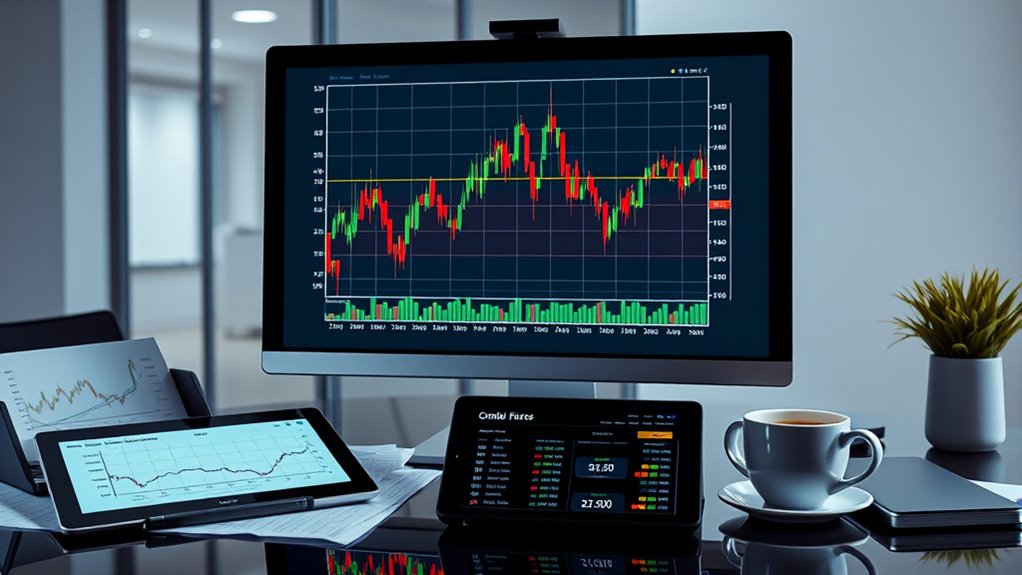To beat dynamic pricing, stay flexible and monitor prices regularly using comparison tools and alerts. Recognize patterns like high demand during peak times and plan purchases during off-peak seasons. Use loyalty programs or subscribe for early deals, and avoid impulsive last-minute buys. By understanding how prices fluctuate based on demand and consumer behavior, you gain an edge. Exploring these strategies further can help you navigate and outsmart dynamic pricing effectively.
Key Takeaways
- Monitor price changes over time using comparison tools to identify patterns and optimal purchase moments.
- Utilize alerts and notifications to stay informed about price drops before making buying decisions.
- Be flexible with your purchasing schedule, avoiding peak seasons and last-minute bookings to dodge inflated prices.
- Leverage loyalty programs and early access discounts to secure lower prices despite dynamic pricing fluctuations.
- Understand your own price elasticity and consumer behavior to strategically time purchases and outsmart pricing strategies.

Dynamic pricing is a strategy where prices change in real-time based on market demand, competition, and other factors. As a consumer, you might notice prices fluctuate when shopping online or booking flights, but understanding how this system works can help you make smarter decisions. One key concept to grasp is price elasticity, which measures how sensitive you are to price changes. If a product has high price elasticity, even a small increase in price can lead you to buy less or look for alternatives. Conversely, low elasticity means you’re less likely to change your purchasing habits regardless of price shifts. Your consumer behavior directly influences how companies set their prices. If they notice that you tend to buy more when prices drop or hesitate when prices rise, they may adjust accordingly to maximize profits.
Understanding price elasticity helps you anticipate how your purchasing habits influence dynamic pricing strategies.
When retailers or service providers utilize dynamic pricing, they analyze patterns in consumer behavior to predict demand. For example, if they see that you tend to purchase airline tickets early in the week or during certain seasons, they might raise prices during peak times and lower them when demand is slower. This responsiveness allows companies to optimize revenue, but it also means your buying patterns can be used to fine-tune their pricing strategies. Knowing this, you should be aware that your willingness to pay at different times influences the prices you encounter. If you tend to buy impulsively or wait for discounts, you can impact how much prices fluctuate.
To beat dynamic pricing, you need to stay informed and adaptable. Track prices over time for the products or services you’re interested in, so you recognize patterns and identify the best times to buy. Use price comparison tools or set alerts that notify you when prices drop. Being flexible with your purchasing schedule can also help you avoid inflated prices during peak demand periods. For instance, if you’re booking flights or hotels, avoid peak travel seasons or last-minute bookings, as prices tend to spike then. Additionally, leverage loyalty programs or subscribe to newsletters that often provide exclusive discounts or early access to sales, giving you an edge over fluctuating prices.
Ultimately, understanding how price elasticity and consumer behavior influence dynamic pricing empowers you to make more strategic choices. Recognize that prices are not fixed and that your buying habits can both influence and be influenced by the pricing system. By staying alert, planning ahead, and utilizing available tools, you can outsmart dynamic pricing and secure better deals. Remember, knowledge is your best weapon in maneuvering a world where prices are constantly shifting, ensuring you don’t pay more than necessary. Moreover, advancements in AI Entertainment like generative AI are beginning to influence how content and services are priced, adding another layer to the pricing landscape you should be aware of.
Frequently Asked Questions
Can Dynamic Pricing Strategies Be Legally Challenged?
Yes, you can legally challenge dynamic pricing strategies if they violate consumer protection laws or involve unfair practices. Legal challenges often focus on transparency, deceptive tactics, or price discrimination. As a consumer, you have the right to seek recourse if you believe a company’s pricing tactics are misleading or unfair. Stay informed about your rights and document any discrepancies to strengthen your case against potentially unlawful dynamic pricing practices.
How Do Algorithms Decide Optimal Prices in Real-Time?
Imagine a busy marketplace where algorithms are like keen shopkeepers, constantly scanning the crowd. They analyze data with complex algorithms, considering factors like demand, competition, and time of day. In real time, they adjust prices swiftly, much like a shopkeeper raising or lowering prices based on foot traffic. These real-time adjustments rely on algorithm complexity, enabling pricing to shift instantly, maximizing profits and staying competitive in a fast-moving digital landscape.
Does Dynamic Pricing Affect Consumer Trust Long-Term?
Yes, dynamic pricing can impact your long-term trust if it fosters consumer skepticism. When prices fluctuate unpredictably, you might question a company’s transparency and motives. To maintain trust, businesses should prioritize pricing transparency, clearly explaining why prices change. As a consumer, stay informed about dynamic pricing strategies and look for brands that openly communicate their pricing models, helping you feel confident in your purchasing decisions and reducing skepticism.
Are There Industries Where Dynamic Pricing Is Less Common?
You’ll find that some industries, like the retail sector and hospitality industry, are less likely to use dynamic pricing. These sectors prefer sticking to fixed prices to keep customer trust intact—after all, you don’t want to rock the boat. While dynamic pricing is common online, brick-and-mortar stores and hotels often favor consistent rates, making them less prone to fluctuating prices and more predictable for you.
How Can Small Businesses Implement Dynamic Pricing Effectively?
You can implement dynamic pricing effectively by focusing on pricing transparency and customer segmentation. Clearly communicate how prices vary to build trust, and use customer data to segment your audience based on behavior, preferences, or purchase history. Adjust prices accordingly while maintaining transparency to avoid customer frustration. This approach helps you optimize revenue, stay competitive, and foster loyalty, even with limited resources.
Conclusion
Now, imagine standing at the edge of a bustling marketplace, prices shifting like the tide beneath your feet. By understanding how dynamic pricing works, you hold the power to navigate these ripples and tides, steering clear of overpaying. With awareness, you become the sailor who charts a steady course through unpredictable waters, always finding calmer, more affordable shores. Master this art, and watch your savings grow as effortlessly as the sun rises each new day.









